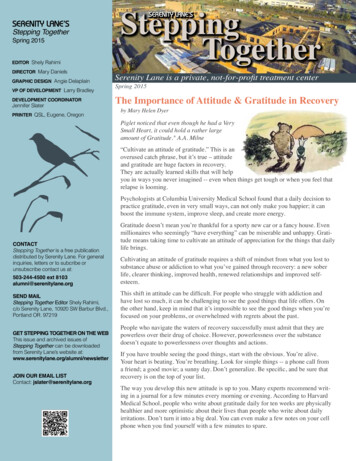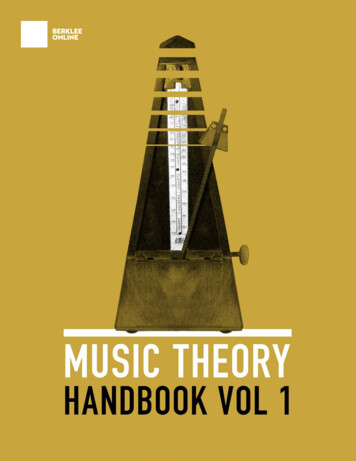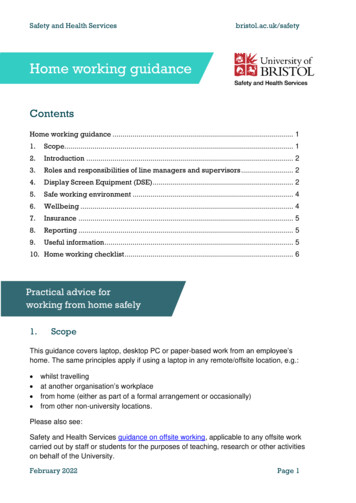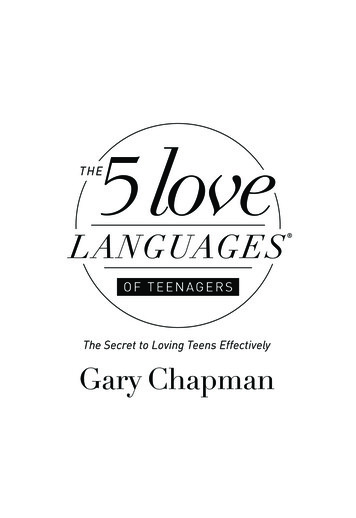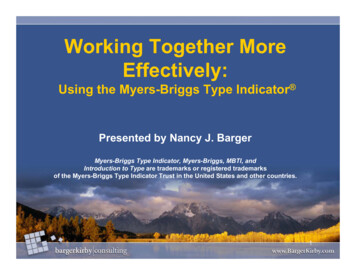
Transcription
Working Together MoreEffectively:Using the Myers-Briggs Type Indicator Presented by Nancy J. BargerMyers-Briggs Type Indicator, Myers-Briggs, MBTI, andIntroduction to Type are trademarks or registered trademarksof the Myers-Briggs Type Indicator Trust in the United States and other countries.1
BargerOrganization development / HR consultant organizational change MBTI instrument applications – Step I and Step II leadership development and coaching diversity, multicultural issues team analysis and interventions2
International ConsultingMBTI qualifying programs, advancedapplications, and organization development in USCanadaUKFinlandDenmark South KoreaAustraliaSingaporeNew ZealandIndiaSouth Africa3
Publications Type and Culture Introduction to Type and Change The Challenge of Change in Organizations WORKTypes (Kummerow, Barger, and Kirby) MBTI Manual, “Use of Type in Organizations,” “Uses ofType in Multicultural Settings” MBTI Applications, “Multicultural Applications”4
The MBTI InstrumentThe most widely-used personality inventory in theworld – translated into 30 languagesI have used it – with excellent success – inCanada The United Kingdom FinlandAustralia New Zealand DenmarkSingapore India South Korea South Africa5
What Is the MBTI Tool? The Myers-Briggs Type Indicator instrumentis a personality inventory It’s designed to identify normal differences inpeople There are no right or wrong answers – onlythe ones that are right for you6
What It’s NOT Is NOT about skills, intelligence,abilities, or technical expertise Does NOT tell you what you can andcan’t do Affirms that people are a lot more thantheir psychological type7
Complete the Form M SelfScorable Answer as you prefer – when not underpressure to act a certain way Answer the 93 questions – Use a ballpoint pen and press firmly DO NOT TEAR OPEN – we will scorelater8
Carl G. JungCarl Gustav Jung, aSwiss psychiatrist(1875 – 1961)developed a theoryof personality.Differences betweenpeople are notrandom, insteadthey form patterns– types.9
Katharine C. BriggsKatharine C. Briggs (1875 –1968), an American, readJung’s PsychologicalTypes in 1923.She spent the next 20 yearsstudying, developing, andapplying Jung’s theory.10
Isabel Briggs MyersIsabel Briggs Myers(1897 – 1980)developed Jung’stheory in partnershipwith Briggs.Beginning in 1943, shedeveloped questionsthat became theMyers-Briggs TypeIndicator instrument.11
MBTI ResultsThe MBTI inventory indicates preferenceson 4 sets of opposites:EExtraversionOR IIntroversionS SensingOR N IntuitionT ThinkingOR F FeelingJ JudgingOR P Perceiving12
What Are “Preferences”?Turn to Introduction to Type , p. 8.In the box in the left-hand column, dowhat it says – sign your name the wayyou always do.13
PreferencesThen, put your pen or pencil in the otherhand and sign your name once again inthe box below.14
PreferencesMost people find the two experiences –writing with the preferred hand and withthe non-preferred hand – quite different.This helps explain what Jung and theMBTI mean by “preferences.”15
16 PatternsThe four preferences can combine in anyway 16 different ways of being normal16
Extraversion or IntroversionThis preference is about mental energy how we get energy how we focus our energy and attention17
Extraversion or IntroversionFrom Introduction to Type & Change, Barger & Kirby, CPP2004, pp. 4 – 5.18
E or IPeople who prefer EPeople who prefer Ienergized byoutside worldenergized by quiet,internal processingactive and involvedreflective andthoughtful19
Work StylesExtraversionIntroversion talk things through think things through take action, get going think before acting want to be involved want to be informed prefer face-to-face prefer writing/one-onone20
Sensing or IntuitionThis preference is about perception how we take in information the kind of information we like and trust21
Sensing or Intuition22
Sensing or IntuitionPeople who prefer SPeople who prefer Nfocus on what ISthrough the sensesfocus on connectionsand meaning in what istrust and rely on“real,” verifiable datatrust and rely on theirinsights, the explanatorypatterns they see23
Work StylesSensingIntuition focus on present realities focus on future possibilities want practical data want the big picture build carefully toconclusions jump to connections andpatterns rely on experience rely on innovative ideas “if it isn’t broke, don’t fix it” “let’s try something new”24
Thinking or FeelingThis preference is about decision-making the way we organize and prioritizeinformation the process we use to make decisions25
Thinking or Feeling26
Thinking or FeelingPeople who prefer TPeople who prefer Fprioritize and decideusing detachedanalysis, logicprioritize and decideusing personal and groupvaluesapply principles offairness and“reasonableness”apply empathy,compassion, attention toindividual needs27
Work StylesThinkingFeeling step back to get anobjective view step into, identify withpeople involved analyze pros & cons assess impacts on people focus on tasks focus on relationships value competence value harmony & support are “fair” are “fair”28
Judging or PerceivingThis last preference looks at the attitudeyou bring to your external life how you organize your environment how you plan and complete tasks29
Judging or Perceiving30
Judging or PerceivingPeople who prefer JPeople who prefer Pseek structure andorder in their dailylifeseek openness andvariety in their dailylifeplan & schedule tomove to completionstay flexible togather information &experiences31
Work StylesJudgingPerceiving want clear goals goals “moving targets” make plans & followthem want flexible plans,options develop schedules &time frames general parameters &time frames drive to “wrap it up” wait for decisions toemerge32
1st Hypothesis – Self EstimateIntroduction to Type , p. 11Write the 4 letters you have chosen. If there wasone where you couldn’t choose, put in a questionmark.E/I/?S/N/?T/F/?J/P/?33
ScoringTear open the booklet (left-hand strip) toscore your results34
35
36
37
Your MBTI Results Show . . .1. The 4 preferences you chose.2. An indication of the clarity with which youreported those.E Moderate38
Your “Best Fit”If the 2 hypotheses are the same:¾ read the full-page description of that type, pp.14 – 29 (Table of Contents lists pages)If the two hypotheses are different on 1 preference:¾ read bothNote things in the description that are likeyou and that are not like you.39
It’s Your Decision!The MBTI questionnaire is a carefully-developed, wellresearched instrument –AND 93 questions cannot tap into all the informationyou have about yourself.To decide on your “best fit” type, consider your results your self-estimate, and the type descriptions40
Adults in the United StatesForm M reported typeNational representative sampleN 3,009Source: MBTI Manual, 3rd ed. (1998), p. 379.Palo Alto, CA: 30%29%41
Adults in the United KingdomStep I (European English) reported typeNational representative sampleN 1,634Source: MBTI Manual, 3rd ed. (1998), p. 379.Palo Alto, CA: 30%25%42
ENFPENTPXESTJLeader43ESFJENFJENTJ
ENFPENTPLeader44ESTJESFJXXXXENFJENTJX
Constructive Use ofDifferences Becoming aware of differences Acknowledging the value of differences Practicing new behaviors, seeking outothers with differences Incorporating different perspectives intoour own processes
Isabel Briggs Myers“I dream thatlong after I’mgone, my workwill go on helpingpeople.”—19795.46
Isabel Briggs Myers Isabel Briggs Myers (1897 – 1980) developed Jung’s theory in partnership with Briggs. Beginning in 1943, she developed questions that became the Myers

